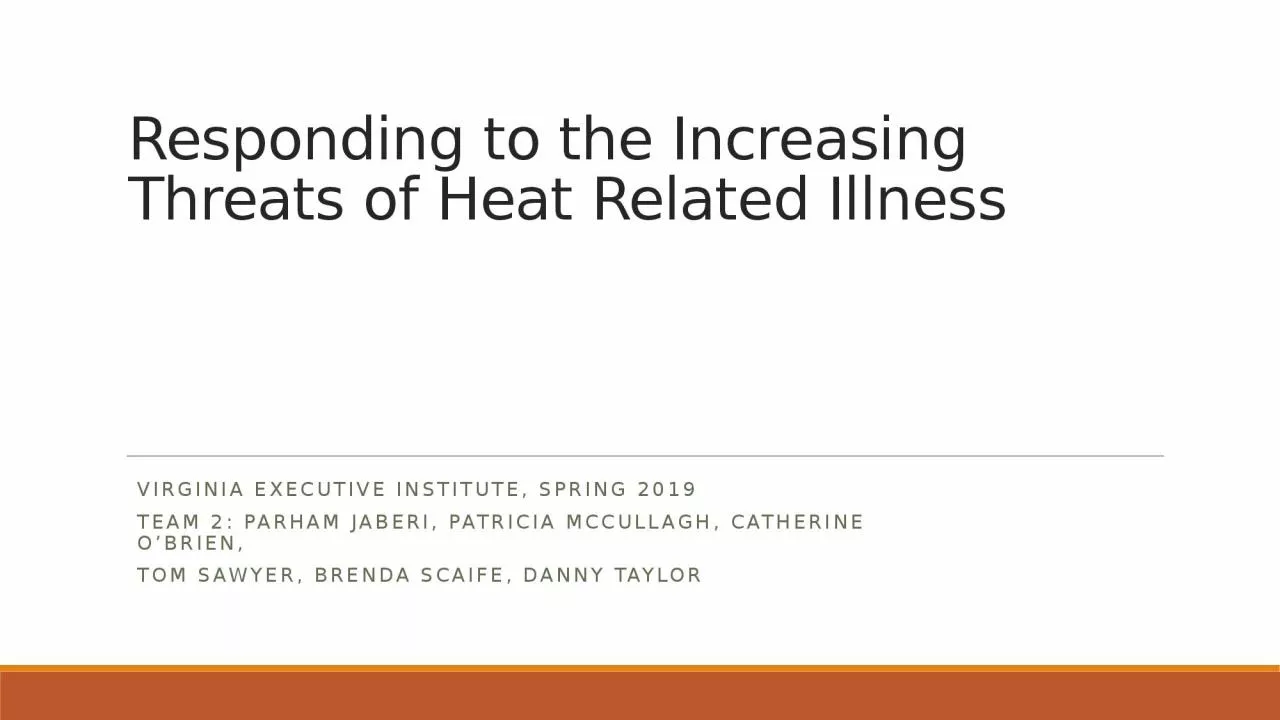

Threats of Heat Related Illness Virginia Executive Institute Spring 2019 Team 2 Parham Jaberi Patricia McCullagh Catherine OBrien Tom Sawyer Brenda Scaife Danny Taylor Background Heat waves have become more frequent and intense and cold waves have become less frequent ID: 933978
Download Presentation The PPT/PDF document "Responding to the Increasing" is the property of its rightful owner. Permission is granted to download and print the materials on this web site for personal, non-commercial use only, and to display it on your personal computer provided you do not modify the materials and that you retain all copyright notices contained in the materials. By downloading content from our website, you accept the terms of this agreement.
Slide1
Responding to the Increasing Threats of Heat Related Illness
Virginia Executive Institute, Spring 2019
Team 2: Parham
Jaberi
, Patricia McCullagh, Catherine O’Brien,
Tom Sawyer, Brenda Scaife, Danny Taylor
Slide2Background
Heat waves have become more frequent and intense, and cold waves have become less frequent.
U.S. average temperatures have increased by 1.3°F to 1.9°F since record keeping began in 1895.
As a result, the Commonwealth must address the resulting public health and economic burden associated with high heat events.
SOURCES: NATIONAL INSTITUTE OF ENVIRONMENTAL HEALTH SCIENCES, 2017
MCMICHAEL & LINDGREN, 2011
Slide3Increasing Global Temperatures
Slide4Heat Index Predictions- More Dangerous Days
SOURCE
:
https://statesatrisk.org/virginia/all
Slide5Health Impacts of Increasing Temperatures
Extreme high air temperatures contribute directly to deaths from cardiovascular and respiratory disease, including heat exhaustion and heat stroke.
More than 600 deaths per year in the United States are due to extreme heat according to the Centers for Disease Control.
Extreme heat causes many people to visit the emergency room or be admitted to the hospital.
As temperatures rise and extreme heat events increase in frequency, we can expect to see more heat-related illnesses and mortality.
SOURCES: NATIONAL INSTITUTE OF ENVIRONMENTAL HEALTH SCIENCES, 2017; USGCRP, 2016 EPA_HEAT-ILLNESS-2016.PDF
Slide6Disproportionate Health Impacts on Select Areas and Populations
High concentrations of buildings and asphalt in urban areas cause
urban heat island effect
, generation and absorbing heat, making the urban center several degrees warmer than surrounding areas.
Susceptible populations are also disproportionately impacted.
SOURCE:
VDH ESSENCE (UCC/ED DATA), RICHMOND AMBULANCE AUTHORITY (AMBULANCE RESPONSES), AND NOAA (TEMPERATURE DATA), COMPILED BY JEREMY HOFFMAN AT SCIENCE MUSEUM OF VIRGINIA
Slide7Economic Impact of Heat Related Health Events
From 2002 through 2009, the health related costs of heat waves in the United States was $5.3 billion.
In 2016, health related costs in the United States were $3.3 trillion.
By the year 2028, it is predicted that heat waves and other climate change effects will add $360 billion per year in heat impact costs. Much of this is due to health costs.
SOURCE: NATURAL RESOURCES DEFENSE COUNCIL ECONOMIC BURDEN OF HOSPITALIZATIONS FOR HEAT-RELATED ILLNESSES IN THE UNITED STATES, INT J ENVIRON RES PUBLIC HEALTH, 2016 SEP. HTTPS://WWW.NCBI.NIM.NIH.GOV/PMC/ARTICLES/PMC5036727/
Slide8Economic Impact of Heat Related Health Events
According to the Red Cross, in recent years, excessive heat has caused more deaths than all other weather events, including floods.
For every 10 degree Fahrenheit increase above mean ambient temperature some states have seen:
393% increase in hospitalization for heat exposure
3% increase in ischemic stroke hospitalizations
15% increase in acute renal failure hospitalizations
On an individual/family level impacts include:
Illness of a family member, loss of income,
Medical bills
Worsening of certain medical conditions (i.e. asthma)
SOURCES: ECONOMIC BURDEN OF HOSPITALIZATIONS FOR HEAT-RELATED ILLNESSES IN THE UNITED STATES, INT J ENVIRON RES PUBLIC HEALTH, 2016 SEP.
HTTPS://WWW.NCBI.NIM.NIH.GOV/PMC/ARTICLES/PMC5036727/
,
https://www.redcross.org/get-help/how-to-prepare-for%20emergencies/types-of-emergencies/heat-wave-safety.html
Slide9Developing a Heat Emergency Response Plan
Though Virginia has an Emergency Operations Plan (“EOP”) to address various emergencies, there is opportunity to further develop a more robust
heat
emergency response plan within this EOP.
Other states may be a resource for how the Commonwealth may want to address this heat response plan (i.e. North Carolina, California).
Potential stakeholders in this heat response plan include:
State agencies
Local Governments and Municipalities
Local Emergency Management/First Responders
Slide10Proposed Plan Components
Determine Parameters for Plan Activation and Termination
Identify the Lead Agency and Supporting Agencies
Establish Communication Strategy and Prevention Messages
Consideration for Opening Cooling Shelters/Hydration Stations
Establish Necessary Training
Measurement of Plan Activation Success and Post Event Plan Revisions
Slide11Summary
Addressing heat related events will benefit both public health and economics in the Commonwealth.
The group recommends that a coordinated heat response plan be incorporated into existing platforms and tools.
Stakeholders should be identified and allowed to discuss and implement methods that will best address the needs and interests affected.
Slide12Questions?